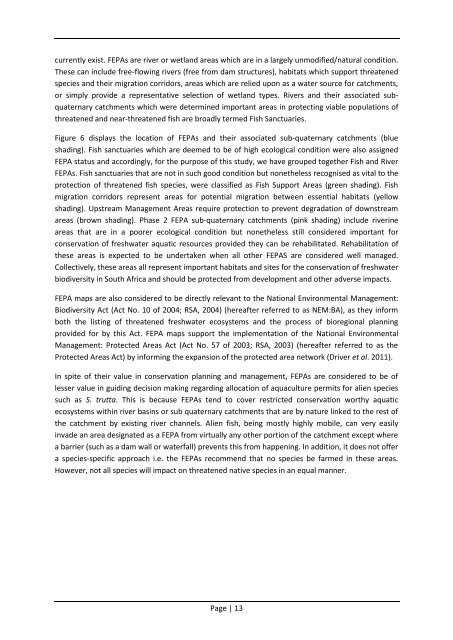Brown trout Salmo trutta - Department of Agriculture, Forestry and ...
Brown trout Salmo trutta - Department of Agriculture, Forestry and ...
Brown trout Salmo trutta - Department of Agriculture, Forestry and ...
You also want an ePaper? Increase the reach of your titles
YUMPU automatically turns print PDFs into web optimized ePapers that Google loves.
currently exist. FEPAs are river or wetl<strong>and</strong> areas which are in a largely unmodified/natural condition.These can include free-flowing rivers (free from dam structures), habitats which support threatenedspecies <strong>and</strong> their migration corridors, areas which are relied upon as a water source for catchments,or simply provide a representative selection <strong>of</strong> wetl<strong>and</strong> types. Rivers <strong>and</strong> their associated subquaternarycatchments which were determined important areas in protecting viable populations <strong>of</strong>threatened <strong>and</strong> near-threatened fish are broadly termed Fish Sanctuaries.Figure 6 displays the location <strong>of</strong> FEPAs <strong>and</strong> their associated sub-quaternary catchments (blueshading). Fish sanctuaries which are deemed to be <strong>of</strong> high ecological condition were also assignedFEPA status <strong>and</strong> accordingly, for the purpose <strong>of</strong> this study, we have grouped together Fish <strong>and</strong> RiverFEPAs. Fish sanctuaries that are not in such good condition but nonetheless recognised as vital to theprotection <strong>of</strong> threatened fish species, were classified as Fish Support Areas (green shading). Fishmigration corridors represent areas for potential migration between essential habitats (yellowshading). Upstream Management Areas require protection to prevent degradation <strong>of</strong> downstreamareas (brown shading). Phase 2 FEPA sub-quaternary catchments (pink shading) include riverineareas that are in a poorer ecological condition but nonetheless still considered important forconservation <strong>of</strong> freshwater aquatic resources provided they can be rehabilitated. Rehabilitation <strong>of</strong>these areas is expected to be undertaken when all other FEPAS are considered well managed.Collectively, these areas all represent important habitats <strong>and</strong> sites for the conservation <strong>of</strong> freshwaterbiodiversity in South Africa <strong>and</strong> should be protected from development <strong>and</strong> other adverse impacts.FEPA maps are also considered to be directly relevant to the National Environmental Management:Biodiversity Act (Act No. 10 <strong>of</strong> 2004; RSA, 2004) (hereafter referred to as NEM:BA), as they informboth the listing <strong>of</strong> threatened freshwater ecosystems <strong>and</strong> the process <strong>of</strong> bioregional planningprovided for by this Act. FEPA maps support the implementation <strong>of</strong> the National EnvironmentalManagement: Protected Areas Act (Act No. 57 <strong>of</strong> 2003; RSA, 2003) (hereafter referred to as theProtected Areas Act) by informing the expansion <strong>of</strong> the protected area network (Driver et al. 2011).In spite <strong>of</strong> their value in conservation planning <strong>and</strong> management, FEPAs are considered to be <strong>of</strong>lesser value in guiding decision making regarding allocation <strong>of</strong> aquaculture permits for alien speciessuch as S. <strong>trutta</strong>. This is because FEPAs tend to cover restricted conservation worthy aquaticecosystems within river basins or sub quaternary catchments that are by nature linked to the rest <strong>of</strong>the catchment by existing river channels. Alien fish, being mostly highly mobile, can very easilyinvade an area designated as a FEPA from virtually any other portion <strong>of</strong> the catchment except wherea barrier (such as a dam wall or waterfall) prevents this from happening. In addition, it does not <strong>of</strong>fera species-specific approach i.e. the FEPAs recommend that no species be farmed in these areas.However, not all species will impact on threatened native species in an equal manner.Page | 13
















